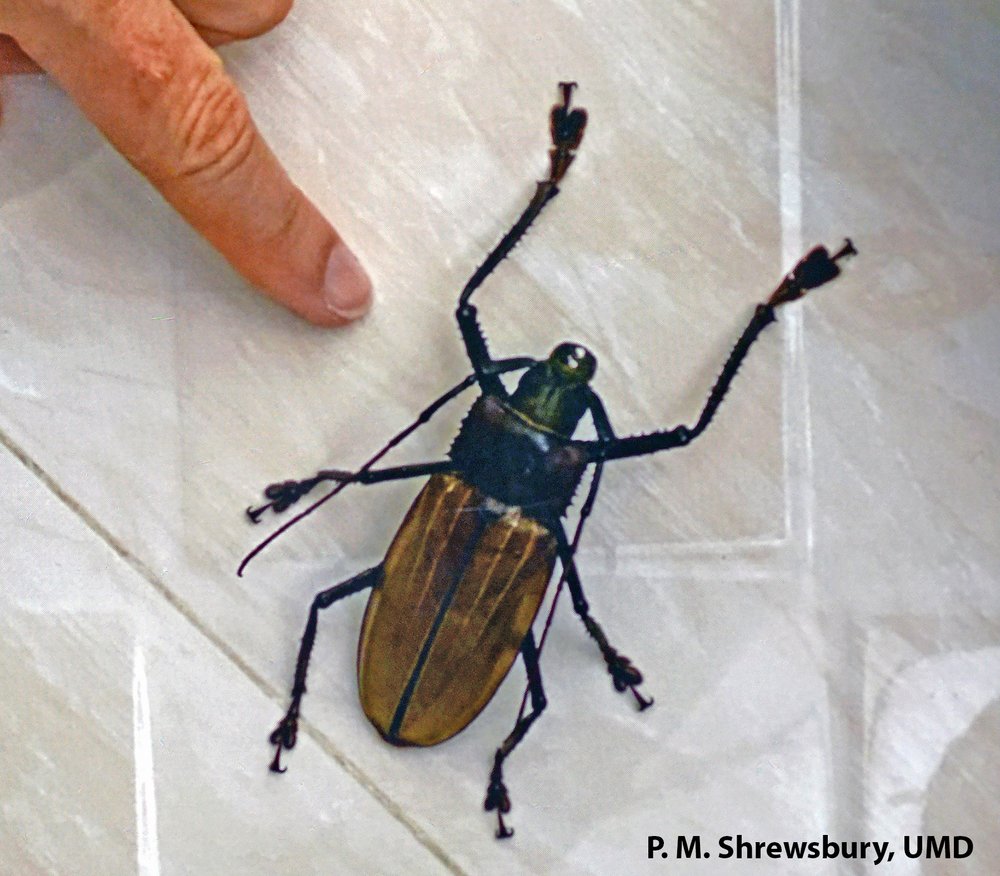Picking up good vibrations from big Bornean beetles: flat-faced (Lamiinae) and tooth-necked (Prioninae) longhorn beetles

One look at this beautiful Batocera beetle makes it easy to understand why they are called longhorn beetles.
Once again, we return to the rainforests of Borneo where in previous episodes we met marvelous millipedes, fierce terrestrial and arboreal ants, and gorgeous lanternflies. This week we meet some of the largest beetles on the planet, longhorn beetles. One look at these supersized insects reveals exactly why they are called longhorn beetles. These beauties have antennae that often exceed the entire length of their body. Despite what some may think, touch is but one of the functions of antennae for insects. In addition to picking up tactile vibrations, antennae are usually festooned with a vast array of chemoreceptors used to detect everything from something good to eat, to where the party is, to who might be the love of their life. Longhorn beetles like the ones you see here can communicate with other members of their species using airborne chemicals called pheromones over distances of hundreds of yards.
One would think that these large beetles would be a prime target for predators like birds and lizards hankering for a tasty high protein meal. Fortunately, these beetles and many other species of insects have a clever trick up their sleeve, or better said, between two thoracic segments of their body. Just behind the beetle’s head on the first segment of the thorax, a small sharp ridge of exoskeleton called the scraper runs transversely across the undersurface surface of the segment. On the segment just behind the first, the exoskeleton bears a patch of tiny regularly spaced ridges and grooves. As the beetle flexes and relaxes these body segments, the scraper moves over the patch of groves, producing a clearly audible sound. These acoustic vibrations, called stridulation, are found in many species of insects and are used to attract mates, defend territories, or as a defense to startle predators. In the case of our very large and beautiful longhorn beetles, when captured they flexed their body up and down, producing an annoying and surprisingly load squeaking sound, not quite fingernails on a chalkboard but close to it.
Borneo has lots of big beautiful longhorn beetles with a cool trick to ward off predators. Listen as this Batocera beetle produces a squeaky sound by rubbing two body segments together. A hard scraper on one segment of its thorax moves across a series of tiny groves and ridges on the segment just behind the first to produce acoustic vibrations called stridulation. We found a huge tooth-necked beetle in a bathroom one morning. This giant really amped up the squeaky alarm when harassed by a human. After scaring and entertaining the humans, upon release, it scampered up a nearby palm tree.

Someone left the light on in the bathroom and someone else had a big surprise when they walked into the bathroom the next morning. Longhorn beetles are really big in Borneo. Credit: P. M. Shrewsbury, UMD
We were fortunate to discover a spectacular toothed-neck longhorn in a bathroom one morning where it was attracted to the lavatory by a light left on overnight. When grabbed by a human, this giant really amped up its stridulatory vibrations. Loud squeaks coupled with flailing legs and spiny body armor made this beetle hard to handle even for a bug geek. One can only imagine the surprise a small barbet gets when it snares a large longhorn beetle and encounters thrashing legs, snapping jaws, and brain-rattling vibrations from its intended meal.
Acknowledgements
Bug of the Week thanks Dan for wrangling the large tooth-necked beetle for this episode and Paula for sharing her images. Kristie, Bob, and Pat provided sterling commentary on stridulation and its importance to longhorn beetles. Two informative references, “Cerambycid Beetle Species with Similar Pheromones are Segregated by Phenology and Minor Pheromone Components” by Robert F. Mitchell, Peter F. Reagel, Joseph C. H. Wong, Linnea R. Meier, Weliton D. Silva, Judith Mongold-Diers, Jocelyn G. Millar, and Lawrence Hanks, and “Stridulatory Apparatus and Analysis of the Acoustics of Four Species of the Subfamily Lamiinae (Coleoptera: Cerambycidae) by Warrren E. Finn, Victor C. Mastro, and Thomas L. Payne, provided insights into stridulation and mating behaviors of longhorn beetles.
This post appeared first on Bug of the Week